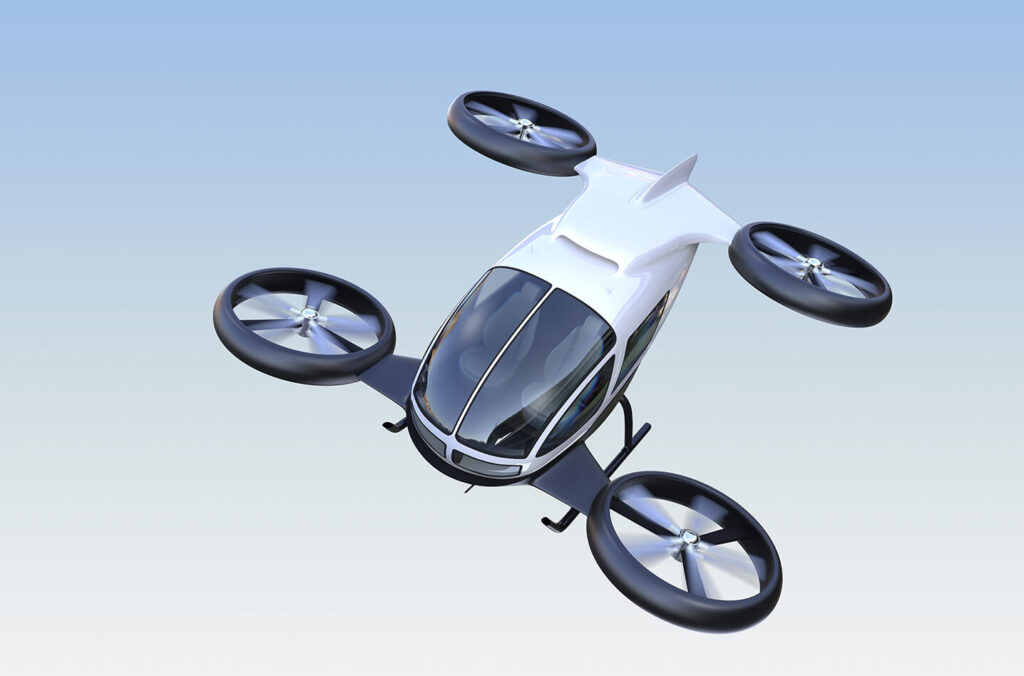
How Advanced Air Mobility Is Changing the Future of Aviation
Blade Runner. Star Wars. Total Recall. Until now, the only flying taxis were the ones you’d find in science fiction movies. But according to proponents of advanced air mobility (AAM), flying cars will soon be commonplace in the real world—helping make air travel faster, safer, more convenient, and more affordable for all.
Defining “Advanced Air Mobility”
The emerging AAM sector is developing an entirely new air-travel ecosystem and market. Technological innovations like automation, cloud computing, 5G telephony, electric motors, and smart infrastructure make it possible to design and build craft that promise to revolutionize the way people and cargo move from place to place. AAM aircraft share a number of common features:
- They take off and land vertically. AAM craft don’t require acres of land for ground operations. They’re able to lift off and land vertically, so they don’t need runways—helipad-like infrastructure called vertiports are all that these aircraft need.
- They’re quiet. AAM craft are powered by electric engines, whihch are much quieter than traditional airplane and helicopter engines.
- They’re sustainable. AAM craft don’t burn fossil fuels, meaning that they don’t contribute to aviation carbon emissions.
- They’re affordable. Airplanes and helicopters typically take months to manufacture, and are expensive to buy, maintain, and operate. AAM craft, by contrast, are significantly smaller—more on the scale of an automobile—can be produced quickly, and are orders of magnitude less expensive to buy, maintain, and operate.
- They enable new aviation business models. With AAM craft, new aviation business models become possible, for businesses like like air taxis, on-demand cargo delivery, and other specialized air travel solutions.
How AAM will change the world
With features like affordability, vertical takeoffs and landings, and quiet and sustainable operations, AAM promises to:
- Revolutionize travel to, within, and from city centers. Because AAM craft are quiet and able to take off from and land on rooftops and small patches of land, they make mass-market air travel possible in even the densest urban settings. Imagine arriving at a major-city airport on a commercial airline flight, then catching an affordable, on-demand AAM flight and arriving to your downtown hotel a in a matter of minutes. No more getting stuck in traffic in a taxi or rideshare! No more battling crowds on mass transit!
- Enhance accessibility to remote or underserved locations and communities. AAM craft can enable affordable access to places that planes can’t—so nobody has to do without.
- Improve emergency services. Ever seen an ambulance that’s stuck in traffic? AAM craft promise to speed response times during medical emergencies and search-and-rescue and disaster-response efforts.
- Create jobs. AAM is an add-on market to existing aviation markets. AAM craft lack the size or range of travel to compete with traditional aviation operators. So AAM promises to create lots of brand-new jobs in manufacturing, construction, ground and air operations, and maintenance.
The imminent arrival of Electric Vertical Takeoff and Landing craft
Already, companies including Archer Aviation, Beta Technologies, Joby Aviation, and Wisk Aero are manufacturing electric vertical takeoff and landing (eVTOL) aircraft (a kind of AAM craft). And the first commercial eVTOL flight operations are expected to launch in late 2025 or early 2026. Key investors in the space include the world’s biggest airplane manufacturers, as well as global auto makers like BMW, Honda, Hyundai, and Toyota, which are hoping to leverage their auto making know-how to scale production and create a mass market for eVTOL craft.
At the same time, there are a number of obstacles that threaten to undermine the growth of the AAM market. For example, the infrastructure necessary to support a mass market for flying taxis does not yet exist—but developers are currently planning and constructing vertiports around the world. And regulatory frameworks for the AAM space will need to be worked out—but the FAA and regulators in other parts of the world have been busy developing certifications, policies and procedures, and rules and regulations to ensure the safety of the AAM flight.
The future of aviation, today
The bottom line is that the flying taxis are coming, and sooner than most of us realize. Some insiders predict that, within a decade, there will be tens of thousands of AAM aircraft served by thousands of vertiports around the world—and one research firm projects the eVTOL market to reach $170 billion by 2034.
And the more distant future looks exciting. Most likely, individuals will be able buy and fly their own AAM craft, bringing us just a bit closer to the world envisioned by The Jetsons. And as technology advances, it may become possible to pilot AAM craft remotely—or even to develop fully autonomous air taxis. Talk about science fiction!
